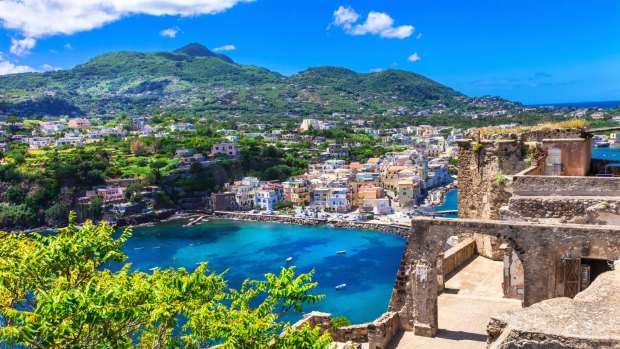This was published 7 years ago
Italy travel tips and advice: Twenty things that will surprise first-time visitors to Italy
By Ben Groundwater
"La dolce vita": those three words sum up so well the picture that most people have of this wonderful country called Italy. It's all about the sweet life there, from the food to the fashion, the villas to the vineyards, the piazzas to the Piaggios. Right? Well, not always…
All those things you're picturing? They exist.
This is the beauty of Italy. Those coastal towns with coloured buildings climbing high on steep mountains above the beach? They exist. Those stripy-shirted Venetian gondoliers singing love songs to the besotted couples in their care? They exist. All those centuries-old Roman ruins, those stone villas, those olive groves, those vineyards, those pavement restaurants with the chequered tablecloths and the beautiful food, those gelaterias, those cathedrals filled with worshippers, those piazzas filled with regulars? They all exist. And they're all amazing.
See also: A lake so beautiful its supernatural
Except Spaghetti Bolognese. That doesn't exist.
Not even in the home of Bolognese-style sauce – Bologna – will you find spaghetti Bolognese. In fact especially not in Bologna. There it's called "tagliatelle al ragu": a flatter, wider style of pasta served with a sauce that's as creamy as it is tomato-based. If you ever find yourself in a restaurant with "spaghetti Bolognese" on the menu, then it's time to high-tail it out of there. You're in a tourist trap.

Some Italian cliches are true.Credit: Getty Images
There are tourists. Lots of tourists.
Your guidebook probably doesn't mention it, but you'll be sharing your Italian touristic experience with what can sometimes feel like pretty much every other person in the entire world. Particularly in summer, Italy is insanely popular, to the point where queues for attractions like the Vatican, the Colosseum and the Uffizi Gallery snake so far down the road that they actually connect up with other queues for other attractions.
There's more to Italy than the "Big 3"

Buildings were damaged and one person killed when an earthquake hit Ischia, Italy.Credit: iStock
Most first-time visitors plan their Italian holiday around three major cities: Rome, Florence and Venice. And there's no doubt that that triumvirate of historic centres has an amazing amount to offer travellers. However, there's more to Italy than that. What about the Amalfi Coast, or Cinque Terre, or Lake Como, or rural Tuscany, or Orvieto, or Milan, or Naples, or Sicily, or Sardinia, or any of the thousands of charming little towns and villages that dot the Italian countryside? This is a small nation that you could spend a lifetime exploring.
See also: Ten reasons to visit south Italy
Some of the clichés are true
There are certain stereotypes about Italy and Italians that you quickly realise are spot on. For starters, yes, the traffic is insane, and if you want to hire a car and join in then you'd better be ready to drive quickly and skilfully and watch out for anyone who can only do one of those things at a time (and it's always the former). Also, no one drinks cappuccinos after about 10.30am, everyone eats a lot of pasta, family always comes first, and Italians really do wave their hands around a lot when they talk.
"Ciao bella" is a thing
This is another one of those stereotypes that rings true. Yes, Italian men are, shall we say, "appreciative" of the female form. Depending on your point of view this can either result in an ego-boosting, flirtatious way to get through the day, or it will be a source of constant and unwanted harassment. It's a fine line that Italians will stomp all over with a Gucci loafer.
Not everyone is fashionable
Speaking of Gucci loafers, here's a funny thing: some Italians really are the epitome of style and panache. It cities such as Milan and Florence and Rome you'll see some almost impossibly chic locals, those who've clearly spent a lot of time and money on putting together an amazing outfit. And then there's everyone else in Italy. Because there are plenty of Italians out there who are not stylish in the slightest. Show me one guy in an Armani suit, and I'll show you 20 blokes in tracky-dacks and football jerseys. Same goes for women. Not everyone is a fashion icon.
See also: The best way to travel in Italy, Italian-style
In Rome, historic sites are everywhere
Put down the guidebook. Ditch the map. Both are completely unnecessary in a city where world-famous historic sites sit literally around every corner. Spend a day wandering around the historic centre of Rome and you will inevitably stumble upon the Piazza Navona, the Trevi Fountain, the Pantheon, the Colosseum, Campo dei Fiori, the Spanish Steps, and plenty of other sights you didn't know existed without even trying.
The pizza is terrible
This is a classic complaint from first-time visitors to Italy: the pizza sucks. And the truth is that in some places, yes, the pizza does suck. But that's because pizza isn't a dish that's eaten across the entire country. It's produced for tourists across the entire country, but it's not actually a part of the local cuisine. For truly great Italian pizza you need to go to either Naples, the home of pizza, or Rome, a close neighbour that's developed its own style. Everywhere else? Forget it.
See also: Where to find the best pizza in Naples
Not everything is postcard perfect
It can be disappointing to find that not everywhere in Italy matches your "la dolce vita" expectations of what this country will be. Venice, for example, is beautiful, but the water in the canals stink. Rome oozes charm, but it's also covered in graffiti, and if you book a hotel around the Termini train station you'll be questioning your own sanity. As with anywhere else in Europe, plenty of Italian cities have their no-go zones.
There's no such thing as a bad coffee
There really isn't. From the dodgiest roadside service stop to the most high-end hotel restaurant, the coffee in Italy is uniformly spectacular. That's because Italians take this stuff seriously. The best and most authentically local way to get your caffeine hit is to walk into any old bar, order an espresso from the cashier, take your ticket over to the barista, wait for your order, and then stand up at the bar to drink it. Yelling in Italian and waving your arms around will also help with the authenticity.
Italy is a nation divided
The longer you spend travelling around Italy the more you realise that it could almost be two separate countries: northern Italy, and the south. Northerners – those from Milan, Turin, Florence, Verona – tend to think of themselves as the industrious ones, the hard workers with money and fashion sense who are forced to prop up the more "laidback" citizens of the south. Those southerners – from Calabria, Siciliy, Puglia – care little for rules, and even less for what the north thinks of them.
Italian bureaucracy is annoying
This is the country that invented roads, sanitation systems, the aqueduct, arches, and the modern calendar. And yet try to do something as simple as post a letter in Italy and you'll find yourself being stonewalled by infuriating bureaucracy. (Hint: the post office doesn't sell envelopes. You'll have to buy them from somewhere else.) This might seem like a laidback, anything-goes sort of country, but any brush with officialdom – public transport, government offices, virtually any state-run business – will leave you pondering how anything gets achieved.
Food is extremely provincial
This is a lesson most people learn the hard way when they order spaghetti carbonara in Florence because, hey, it's Italian. But that's not how Italy works. Pretty much all of the dishes the country is famous for are only specialties of certain regions, which is why you need to do your homework and know what to order. Go for bistecca in Florence, salumi and Parmiggiano in Bologna, carbonara in Rome, risotto in Milan, pizza in Naples, arancini in Sicily, seafood in Calabria, and orecchiette in Puglia. Even certain words differ between regions – while most of Italy orders a "cappuccino e cornetto" for breakfast, around Milan it's a "cappuccio e brioche".
Some attractions are extremely overrated…
You could be forgiven for rolling up at the Spanish Steps in Rome and assuming you were in the wrong spot. What's so great about these things? Why are they so famous? It's just a staircase. Some people are even disappointed by the Leaning Tower of Pisa. It's a tower with a slight lean – got it. And don't get us started on "Juliette's balcony" in Verona.
…While others deserve far more attention
For some reason everyone talks about St Peter's Basilica in Rome, but you don't hear so much about the Duomo in Florence. Similarly, you hear all about the Florence's Uffizi Gallery, but what about Rome's Villa Borghese? And you'll find so many more relatively little-known gems. There's the entire walled city of Lucca; the rugged coastline of northern Sardinia; the Roman ruins of Lecce; the little fishing ports in Calabria; and the ancient marketplaces in Bologna. The list could go on.
You have to pay to go to the beach
Australians are brought up on the concept of public beaches as an inalienable human right, so it can be a bit of an affront to find you're being charged to hit the sand in Italy. However, that's the way it works. While there are plenty of free public beaches, there are also "lidos" where you'll have to pay to hire a deck chair and an umbrella if you want to hang out for the day.
Siesta happens
The further south you go in Italy, the hotter it gets, and the more likely everyone is to shut up shop for a few hours every afternoon to go home for a nap. This will be annoying to begin with, as you attempt to go out shopping after lunch and find yourself in a ghost town. However, it doesn't take long before an afternoon kip is worked into your own schedule. It's great. Many shops also close on Sundays, which can catch people out.
Beware of bars or cafes with a view
This is Italy's golden rule: if your bar or café of choice happens to be situated right in front of a world-famous monument, or if it's in the middle of a touristy piazza, or if it has an incredible view of a city or landscape, then the drinks will be overpriced, the food will be average, and the service will be bad. They're quite often lovely places to sit – you just need to know what you're getting yourself into.
Italians are rebels
There's an anti-authoritarian streak that lives in most Italians, and that rebelliousness probably explains much about this gloriously chaotic and unpredictable nation. Yes, tax avoidance is high, which means there's no money for things like reliable public transport. No, no one is likely to turn up when they say they're going to, because that's just the way it is. The traffic is bonkers, the garbage hasn't been picked up in weeks, people are talking on mobile phones while riding scooters, and the whole place looks like it's about to fall apart. But still – you have to love it.
See also: The 10 best ways to save money travelling in Europe
See also: Italy's best pizza? It's not that good
Sign up for the Traveller Deals newsletter
Get exclusive travel deals delivered straight to your inbox. Sign up now.